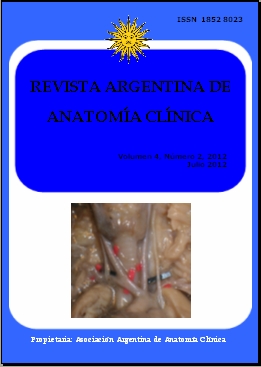VARIANT POSITION OF THE GALLBLADDER ASSOCIATED WITH ABNORMAL PERITONEAL FOLD AROUND IT. Variantes en la posición de la vesícula biliar asociada con un pliegue peritoneal anormal a su alrededor
DOI:
https://doi.org/10.31051/1852.8023.v4.n2.14024Keywords:
Gallbladder, peritoneal fold, volvulus, ventral mesentry, transverse colon, transverse mesocolon, vesícula biliar, pliegue peritoneal, vólvulo, mesenterio ventral, colon transverso, mesocolon transversoAbstract
Los pliegues peritoneales anómalos alrededor de la vesícula biliar son muy raros y pocos fueron reportados en el pasado. La presencia de tales pliegues peritoneales son probablemente debidos a la extensión del mesenterio ventral que forma el omento menor. En el caso presente, reportamos un pliegue peritoneal anómalo suspendiendo la vesícula biliar desde la superficie inferior del hígado, a lo largo de la margen izquierda de la fosa para la vesícula biliar. Este pliegue, cuando se trazó cuidadosamente, se continuaba con el colon transverso, mesocolon transverso y también se encontró fusionado con la segunda porción del duodeno. La vesícula biliar con inusuales pliegues peritoneales tiene tendencia a vólvulo, una rara enfermedad que exige la intervención quirúrgica inmediata. El conocimiento de la posibilidad de tal anomalía peritoneal alrededor de la vesícula biliar facilita la interpretación de los hallazgos de la imagen para el diagnostico apropiado.
Anomalous peritoneal folds around the gallbladder are very rare and a few were reported in the past. The presence of such peritoneal folds is probably due to extension of the ventral mesentery which forms the lesser omentum. In the present case we report anomalous peritoneal fold suspending the gall bladder from the undersurface of the liver, along the left margin of the fossa for gallbladder. This fold, when traced carefully, became continuous with transverse colon, transverse mesocolon and also found to be merged with the second part of duodenum. The gallbladder with unusual peritoneal folds has a tendency to volvulus, a rare surgical disease which demands the immediate surgical intervention. Awareness of the possibility of such peritoneal anomaly around gallbladder facilitates the interpretation of image findings for proper diagnosis.
References
McHenry CR, Byrne MP. 1986. Gallbladder volvulus in the elderly. An emergent surgical disease. J Am Geriatr Soc 34: 137-139.
Moore KL, Persaud TVN. 2003. The Developing Human – Clinically oriented embryology. 7th Ed Philadelphia. Saunders, 256-275.
Nayak BS. 2009. Abnormal peritoneal fold connecting the greater omentum with the liver, gallbladder, right kidney and lesser omentum. Bratisl Lek Listy 110: 736-737.
Pamidi N, Nayak S, Volllala VR. 2008. Cystogastrocolic fold and associated atrophy of the gall Bladder. Singapore med J 49: 250.
Shaikh AA, Charles A, Domingo S, Schaub G. 2005. Gallbladder volvulus: report of two original cases and review of the literature. Am Surg 71: 87-89.
Sheila Sherlock. 1993. Text book of liver and biliary system. 9th Ed London. Blackwell scientific, 559.
Sridevi NS, Bhaskaran A, Roopa Kulkarni, Nandish C, Sangeeta M. 2011. An unusual anomalous peritoneal fold around the gall bladder. Anatomica Karnataka 5: 66-68.
Tarhan OR, Barut I, Dinelek H. 2006. Gall Bladder volvulus: Review of the literature and report of the case. Turkish journal of gastro enterology 17: 209-11.
Tzardinoglou E, Prousalidis J, Apostolidis S, Katsohis C, Aletras H. 1996. Hanging noncalculous gallbladder. HPB Surg 9: 137-139.
Wendel AV.1898. A case of floating gallbladder and kidney complicated by cholelithiasis and perforation of the gallbladder. Ann Surg 27: 199
Downloads
Published
Issue
Section
License
Authors retain copyright and grant the journal right of first publication with the work simultaneously licensed under a Creative Commons Attribution License that allows others to share the work with an acknowledgement of the work's authorship and initial publication in this journal. Use restricted to non commercial purposes.
Once the manuscript has been accepted for publications, authors will sign a Copyright Transfer Agreement to let the “Asociación Argentina de Anatomía Clínica” (Argentine Association of Clinical Anatomy) to edit, publish and disseminate the contribution.



